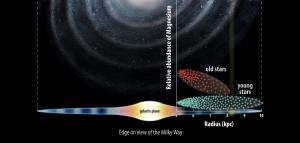Blog
Inside Out
21 January 2014
 University of Cambridge
University of CambridgeThe Gaia spacecraft was just launched in December, and while it hasn’t started gathering data yet, the project to support Gaia has already begun to discover new things about our galaxy. The purpose of the Gaia spacecraft is to map stars in our galaxy. It’s goal is to map a billion stars, including spectral analysis, which will tell us about their composition. This week a paper was submitted to Astronomy and Astrophysics that analyzes some project data to look at the metallicity of stars in the galaxy.1
Metallicity is a measure of how much metal (which in astronomy means everything not hydrogen or helium) a star contains. Since metals can only be formed in the cores of stars, the higher the metallicity the younger the star. For example, our Sun has a relatively high metallicity, which means it must have formed from the remnants of a few generations of stars.
We’ve known for a while that stars within the plane of our galaxy tend to be high metallicity, while those in the surrounding halo tend to have low metallicity. This new research looked at this distribution in more detail. Specifically it looked at levels of magnesium in different stars. The reason magnesium was chosen is that large quantities of it is produced in the cores of large, short lived stars. In the early history of our galaxy, these are the type of stars that would become supernovae first, so stars with higher levels of magnesium would have formed from the remnants of these early stars.
What the team found was that stars closer to the center of our galaxy than the Sun have higher levels of magnesium, while stars further away from the center than the Sun have lower levels of magnesium. This would seem to indicated that stars formed near the center of the galaxy first, with stars farther from the center forming later. A galaxy forming from the inside out, as it were.
Of course this paper hasn’t been peer reviewed, though I expect it will be soon. This is just the first chapter in what will likely be a very interesting story.
Bergemann, Maria, et al. “The Gaia-ESO Survey: radial metallicity gradients and age-metallicity relation of stars in the Milky Way disk.” Astronomy & Astrophysics 565 (2014): A89. ↩︎